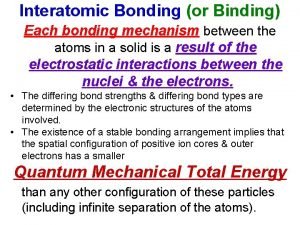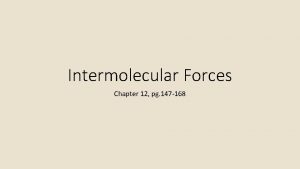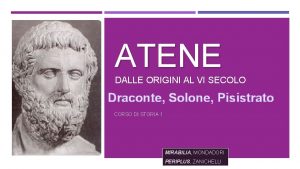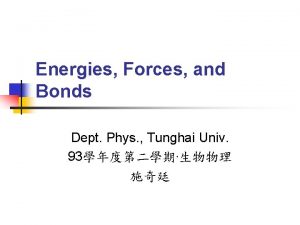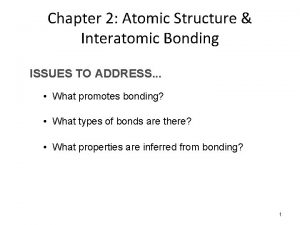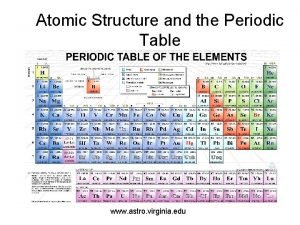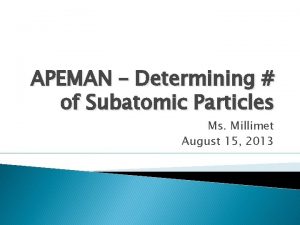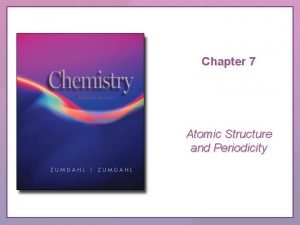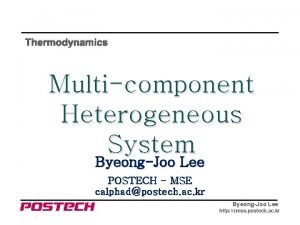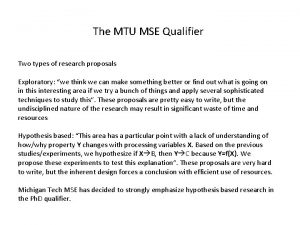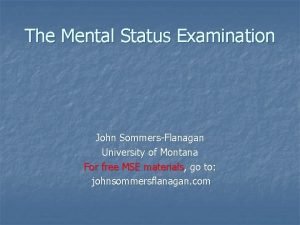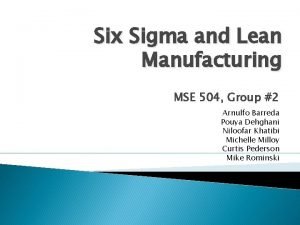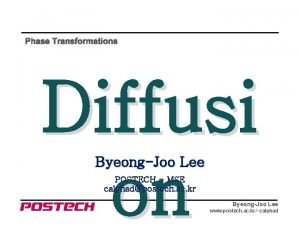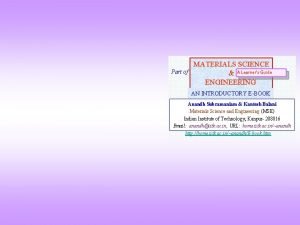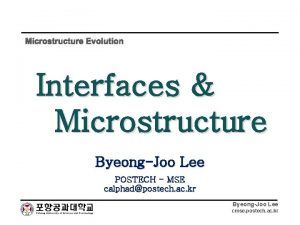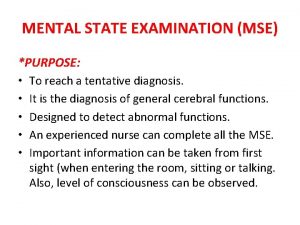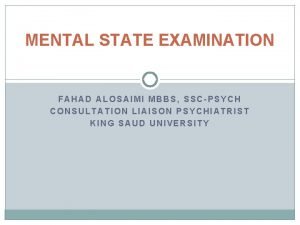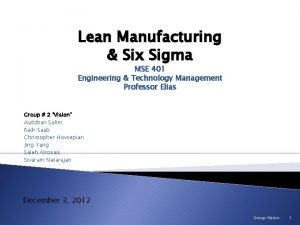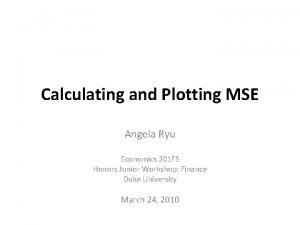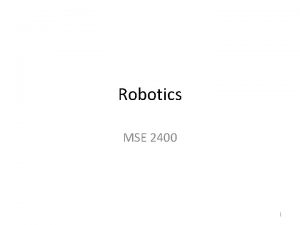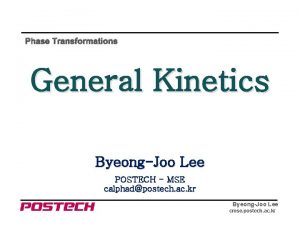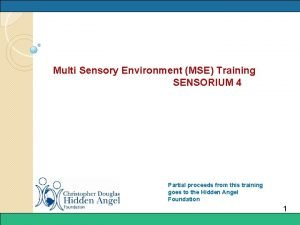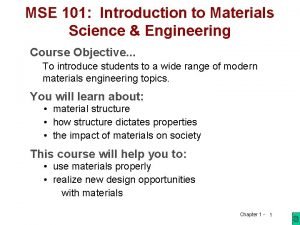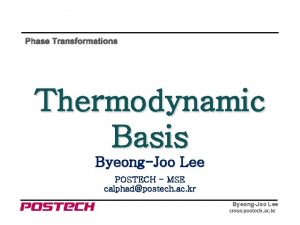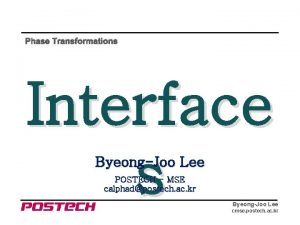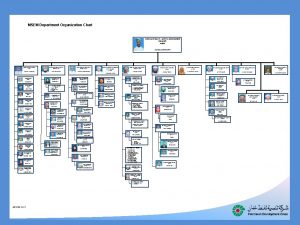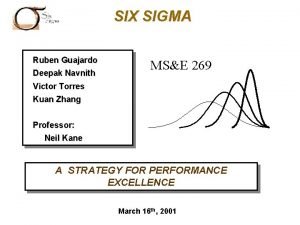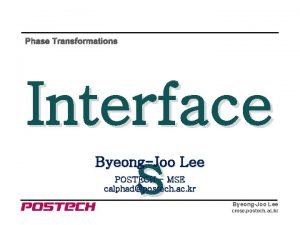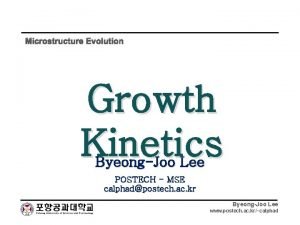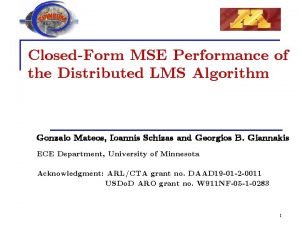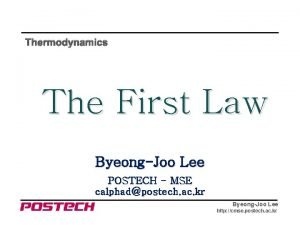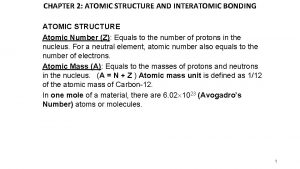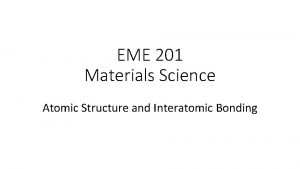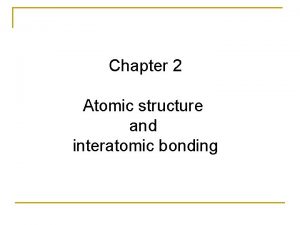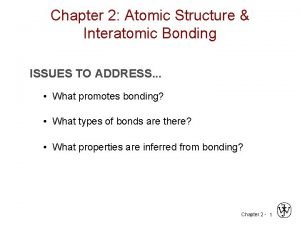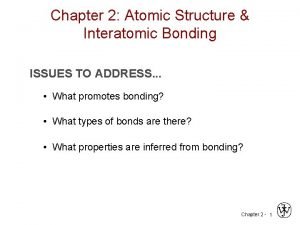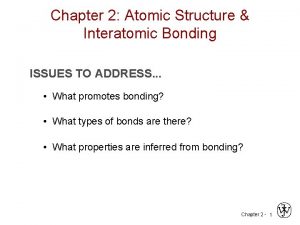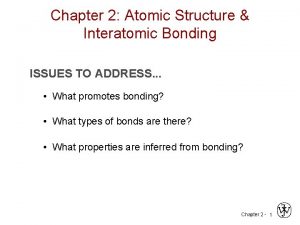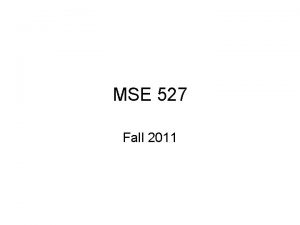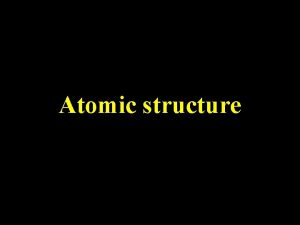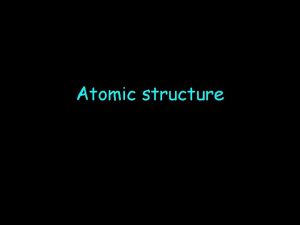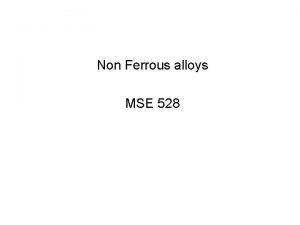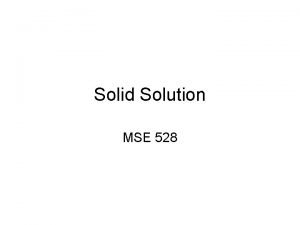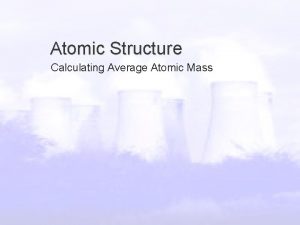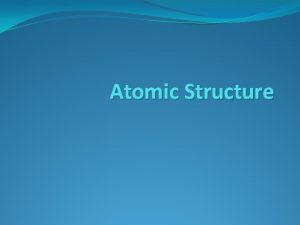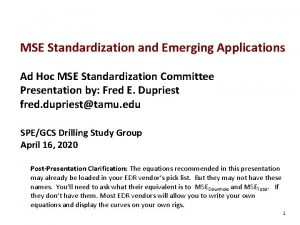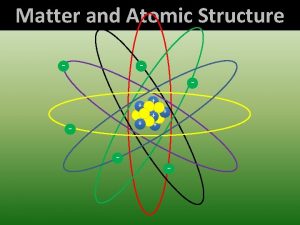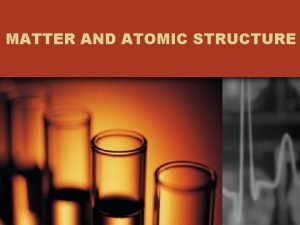MSE 528 Fall 2010 Atomic Structure and Interatomic

























































- Slides: 57

MSE 528 Fall 2010










Atomic Structure and Interatomic Bonding ISSUES TO ADDRESS. . . • What promotes bonding? • What types of bonds are there? • What properties are inferred from bonding? 1

BOHR ATOM Adapted from Fig. 2. 1, Callister 6 e. Nucleus: Z = # protons = 1 for hydrogen to 94 for plutonium N = # neutrons Atomic mass A ≈ Z + N 2

ELECTRON ENERGY STATES Electrons. . . • have discrete energy states • tend to occupy lowest available energy state. Adapted from Fig. 2. 5, Callister 6 e. 3

STABLE ELECTRON CONFIGURATIONS Stable electron configurations. . . • have complete s and p subshells • tend to be unreactive. Adapted from Table 2. 2, Callister 6 e. 4

SURVEY OF ELEMENTS • Most elements: Electron configuration not stable. Adapted from Table 2. 2, Callister 6 e. • Why? Valence (outer) shell usually not filled completely. 5

THE PERIODIC TABLE • Columns: Similar Valence Structure Adapted from Fig. 2. 6, Callister 6 e. Electropositive elements: Readily give up electrons to become + ions. Electronegative elements: Readily acquire electrons to become - ions. 6

ELECTRONEGATIVITY • Ranges from 0. 7 to 4. 0, • Large values: tendency to acquire electrons. Smaller electronegativity Larger electronegativity Adapted from Fig. 2. 7, Callister 6 e. (Fig. 2. 7 is adapted from Linus Pauling, The Nature of the Chemical Bond, 3 rd edition, Copyright 1939 and 1940, 3 rd edition. Copyright 1960 by Cornell University. 7

IONIC BONDING • • Occurs between + and - ions. Requires electron transfer. Large difference in electronegativity required. Example: Na. Cl 8

EXAMPLES: IONIC BONDING • Predominant bonding in Ceramics Give up electrons Acquire electrons Adapted from Fig. 2. 7, Callister 6 e. (Fig. 2. 7 is adapted from Linus Pauling, The Nature of the Chemical Bond, 3 rd edition, Copyright 1939 and 1940, 3 rd edition. Copyright 1960 by Cornell University. 9

COVALENT BONDING • Requires shared electrons • Example: CH 4 C: has 4 valence e, needs 4 more H: has 1 valence e, needs 1 more Electronegativities are comparable. Adapted from Fig. 2. 10, Callister 6 e. 10

EXAMPLES: COVALENT BONDING • • Molecules with nonmetals Molecules with metals and nonmetals Elemental solids (RHS of Periodic Table) Compound solids (about column IVA) 11

METALLIC BONDING • Arises from a sea of donated valence electrons (1, 2, or 3 from each atom). Adapted from Fig. 2. 11, Callister 6 e. • Primary bond for metals and their alloys 12

SECONDARY BONDING Arises from interaction between dipoles • Fluctuating dipoles Adapted from Fig. 2. 13, Callister 6 e. • Permanent dipoles-molecule induced -general case: Adapted from Fig. 2. 14, Callister 6 e. -ex: liquid HCl Adapted from Fig. 2. 14, Callister 6 e. -ex: polymer 13

SUMMARY: BONDING Type Bond Energy Comments Ionic Large! Nondirectional (ceramics) Covalent Variable large-Diamond small-Bismuth Directional semiconductors, ceramics polymer chains) Metallic Variable large-Tungsten small-Mercury Nondirectional (metals) smallest Directional inter-chain (polymer) inter-molecular Secondary 14

PROPERTIES FROM BONDING: TM • Bond length, r • Melting Temperature, Tm • Bond energy, Eo Tm is larger if Eo is larger. 15

PROPERTIES FROM BONDING: E • Elastic modulus, E • E ~ curvature at ro E is larger if Eo is larger. 16

PROPERTIES FROM BONDING: a • Coefficient of thermal expansion, a • a ~ symmetry at ro a is larger if Eo is smaller. 17

SUMMARY: PRIMARY BONDS Ceramics (Ionic & covalent bonding): Metals (Metallic bonding): Polymers (Covalent & Secondary): Large bond energy large Tm large E small a Variable bond energy moderate Tm moderate E moderate a Directional Properties Secondary bonding dominates small T small E large a 18

Structures of Metals and Ceramics ISSUES TO ADDRESS. . . • How do atoms assemble into solid structures? • How do the structures of ceramic materials differ from those of metals? • How does the density of a material depend on its structure? • When do material properties vary with the sample (i. e. , part) orientation? 1

ENERGY AND PACKING • Non dense, random packing • Dense, regular packing Dense, regular-packed structures tend to have lower energy. 2

METALLIC CRYSTALS • tend to be densely packed. • have several reasons for dense packing: -Typically, only one element is present, so all atomic radii are the same. -Metallic bonding is not directional. -Nearest neighbor distances tend to be small in order to lower bond energy. • have the simplest crystal structures. We will look at three such structures. . . 3


SIMPLE CUBIC STRUCTURE (SC) • Rare due to poor packing (only Po has this structure) • Close-packed directions are cube edges. • Coordination # = 6 (# nearest neighbors) Click on image to animate (Courtesy P. M. Anderson) 4

ATOMIC PACKING FACTOR • APF for a simple cubic structure = 0. 52 Adapted from Fig. 3. 19, Callister 6 e. 5

FACE CENTERED CUBIC STRUCTURE (FCC) • Close packed directions are face diagonals. --Note: All atoms are identical; the face-centered atoms are shaded differently only for ease of viewing. • Coordination # = 12 Click on image to animate (Courtesy P. M. Anderson) Adapted from Fig. 3. 1(a), Callister 6 e. 6

ATOMIC PACKING FACTOR: FCC • APF for a body-centered cubic structure = 0. 74 Adapted from Fig. 3. 1(a), Callister 6 e. 7

BODY CENTERED CUBIC STRUCTURE (BCC) • Close packed directions are cube diagonals. --Note: All atoms are identical; the center atom is shaded differently only for ease of viewing. • Coordination # = 8 Click on image to animate (Courtesy P. M. Anderson) Adapted from Fig. 3. 2, Callister 6 e. 8

ATOMIC PACKING FACTOR: BCC • APF for a body-centered cubic structure = 0. 68 Adapted from Fig. 3. 2, Callister 6 e. 9

HEXAGONAL CLOSE-PACKED STRUCTURE (HCP) • ABAB. . . Stacking Sequence • 3 D Projection • 2 D Projection Adapted from Fig. 3. 3, Callister 6 e. • Coordination # = 12 • APF = 0. 74 10

THEORETICAL DENSITY, r Example: Copper Data from Table inside front cover of Callister (see next slide): • crystal structure = FCC: 4 atoms/unit cell • atomic weight = 63. 55 g/mol (1 amu = 1 g/mol) -7 • atomic radius R = 0. 128 nm (1 nm = 10 cm) 11

Characteristics of Selected Elements at 20 C Adapted from Table, "Characteristics of Selected Elements", inside front cover, Callister 6 e. 12

DENSITIES OF MATERIAL CLASSES Why? Metals have. . . • close-packing (metallic bonding) • large atomic mass Ceramics have. . . • less dense packing (covalent bonding) • often lighter elements Polymers have. . . • poor packing (often amorphous) • lighter elements (C, H, O) Composites have. . . • intermediate values Data from Table B 1, Callister 6 e. 13

CERAMIC BONDING • Bonding: --Mostly ionic, some covalent. --% ionic character increases with difference in electronegativity. • Large vs small ionic bond character: Adapted from Fig. 2. 7, Callister 6 e. (Fig. 2. 7 is adapted from Linus Pauling, The Nature of the Chemical Bond, 3 rd edition, Copyright 1939 and 1940, 3 rd edition. Copyright 1960 by Cornell University. 14

IONIC BONDING & STRUCTURE • Charge Neutrality: --Net charge in the structure should be zero. --General form: • Stable structures: --maximize the # of nearest oppositely charged neighbors. Adapted from Fig. 12. 1, Callister 6 e. 15

COORDINATION # AND IONIC RADII • Coordination # increases with Issue: How many anions can you arrange around a cation? Adapted from Fig. 12. 4, Callister 6 e. Adapted from Fig. 12. 2, Callister 6 e. Adapted from Table 12. 2, Callister 6 e. Adapted from Fig. 12. 3, Callister 6 e. 16

EX: PREDICTING STRUCTURE OF Fe. O • On the basis of ionic radii, what crystal structure would you predict for Fe. O? • Answer: based on this ratio, --coord # = 6 --structure = Na. Cl Data from Table 12. 3, Callister 6 e. 17

Am. Xp STRUCTURES • Consider Ca. F 2 : • Based on this ratio, coord # = 8 and structure = Cs. Cl. • Result: Cs. Cl structure w/only half the cation sites occupied. • Only half the cation sites are occupied since #Ca 2+ ions = 1/2 # F- ions. Adapted from Fig. 12. 5, Callister 6 e. 18

DEMO: HEATING AND COOLING OF AN IRON WIRE • Demonstrates "polymorphism" The same atoms can have more than one crystal structure. 19

FCC STACKING SEQUENCE • ABCABC. . . Stacking Sequence • 2 D Projection • FCC Unit Cell 20

STRUCTURE OF COMPOUNDS: Na. Cl • Compounds: Often have similar close-packed structures. • Structure of Na. Cl • Close-packed directions --along cube edges. Click on image to animate (Courtesy P. M. Anderson) 21

CRYSTALS AS BUILDING BLOCKS • Some engineering applications require single crystals: --diamond single crystals for abrasives --turbine blades (Courtesy Martin Deakins, GE Superabrasives, Worthington, OH. Used with permission. ) Fig. 8. 30(c), Callister 6 e. (Fig. 8. 30(c) courtesy of Pratt and Whitney). • Crystal properties reveal features of atomic structure. --Ex: Certain crystal planes in quartz fracture more easily than others. (Courtesy P. M. Anderson) 22

POLYCRYSTALS • Most engineering materials are polycrystals. 1 mm Adapted from Fig. K, color inset pages of Callister 6 e. (Fig. K is courtesy of Paul E. Danielson, Teledyne Wah Chang Albany) • Nb-Hf-W plate with an electron beam weld. • Each "grain" is a single crystal. • If crystals are randomly oriented, overall component properties are not directional. • Crystal sizes typ. range from 1 nm to 2 cm (i. e. , from a few to millions of atomic layers). 23

SINGLE VS POLYCRYSTALS • Single Crystals Data from Table 3. 3, Callister 6 e. (Source of data is R. W. Hertzberg, Deformation and Fracture Mechanics of Engineering Materials, 3 rd ed. , John Wiley and Sons, 1989. ) -Properties vary with direction: anisotropic. -Example: the modulus of elasticity (E) in BCC iron: • Polycrystals -Properties may/may not vary with direction. -If grains are randomly oriented: isotropic. (Epoly iron = 210 GPa) -If grains are textured, anisotropic. 200 mm Adapted from Fig. 4. 12(b), Callister 6 e. (Fig. 4. 12(b) is courtesy of L. C. Smith and C. Brady, the National Bureau of Standards, Washington, DC [now the National Institute of Standards and Technology, Gaithersburg, MD]. ) 24

X-RAYS TO CONFIRM CRYSTAL STRUCTURE • Incoming X-rays diffract from crystal planes. Adapted from Fig. 3. 2 W, Callister 6 e. • Measurement of: Critical angles, qc, for X-rays provide atomic spacing, d. 25

MATERIALS AND PACKING Crystalline materials. . . • atoms pack in periodic, 3 D arrays • typical of: -metals -many ceramics -some polymers crystalline Si. O 2 Adapted from Fig. 3. 18(a), Callister 6 e. Noncrystalline materials. . . • atoms have no periodic packing • occurs for: -complex structures -rapid cooling "Amorphous" = Noncrystalline noncrystalline Si. O 2 Adapted from Fig. 3. 18(b), Callister 6 e. 26

GLASS STRUCTURE • Basic Unit: • Glass is amorphous • Amorphous structure occurs by adding impurities (Na+, Mg 2+, Ca 2+, Al 3+) • Impurities: interfere with formation of crystalline structure. • Quartz is crystalline Si. O 2: (soda glass) Adapted from Fig. 12. 11, Callister, 6 e. 28

SUMMARY • Atoms may assemble into crystalline or amorphous structures. • We can predict the density of a material, provided we know the atomic weight, atomic radius, and crystal geometry (e. g. , FCC, BCC, HCP). • Material properties generally vary with single crystal orientation (i. e. , they are anisotropic), but properties are generally non-directional (i. e. , they are isotropic) in polycrystals with randomly oriented grains. 27
 Inter atomic bonding
Inter atomic bonding Pg 147
Pg 147 Arch 528
Arch 528 Sebuah kaleng berbentuk prisma berisi minyak tanah 27 liter
Sebuah kaleng berbentuk prisma berisi minyak tanah 27 liter 546-528 a.c
546-528 a.c Interatomic bonds
Interatomic bonds Interatomic bonding
Interatomic bonding Relative atomic mass of beryllium
Relative atomic mass of beryllium How do you calculate atomic mass
How do you calculate atomic mass Atomic mass and atomic number difference
Atomic mass and atomic number difference Patterns in the periodic table
Patterns in the periodic table Ionic radius trend
Ionic radius trend Atomic number vs atomic radius
Atomic number vs atomic radius After the fall 2010
After the fall 2010 Atomic structure and properties ap chemistry
Atomic structure and properties ap chemistry Ap chemistry atomic structure and periodicity
Ap chemistry atomic structure and periodicity Structure of an atom
Structure of an atom Apeman practice
Apeman practice Oxygen periodic trends
Oxygen periodic trends Chapter 7 atomic structure and periodicity
Chapter 7 atomic structure and periodicity Postech mse
Postech mse Mtu mse
Mtu mse Mse report sample
Mse report sample Cognition mse
Cognition mse Mse in counseling
Mse in counseling Mse six sigma
Mse six sigma Quality and operations management
Quality and operations management Mse psychiatry
Mse psychiatry Postech mse
Postech mse Mse iitk
Mse iitk Multiple regression dataset
Multiple regression dataset Susan davidson upenn
Susan davidson upenn Postech mse
Postech mse Mse summary
Mse summary Insight and judgement examples
Insight and judgement examples Mse appearance
Mse appearance Mse six sigma
Mse six sigma Thought content examples
Thought content examples Mse calculation
Mse calculation Mse nthu
Mse nthu Mse-2400
Mse-2400 Postech mse
Postech mse Ir. ary sudijanto mse
Ir. ary sudijanto mse Sensorium mse
Sensorium mse Mse 101
Mse 101 Eacademics iitd student login
Eacademics iitd student login Postech mse
Postech mse Postech mse
Postech mse Mse org chart
Mse org chart Mse six sigma
Mse six sigma Provrbs
Provrbs Postech mse
Postech mse Mse total cost
Mse total cost Postech mse
Postech mse Csun ece 240
Csun ece 240 Mse fisioterapia
Mse fisioterapia Qqqnn
Qqqnn Postech mse
Postech mse
